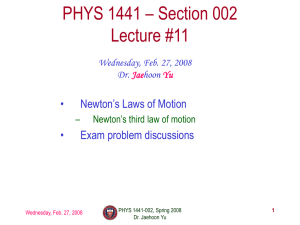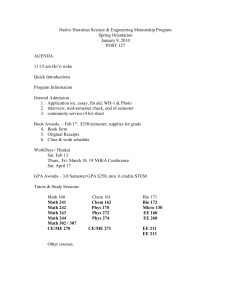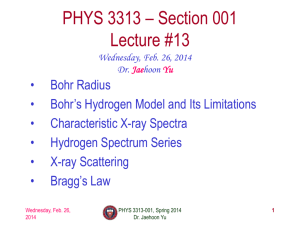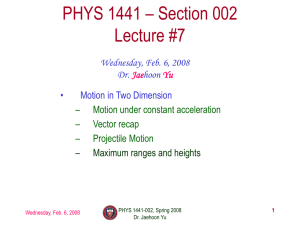Wednesday, Feb. 8, 2012
advertisement
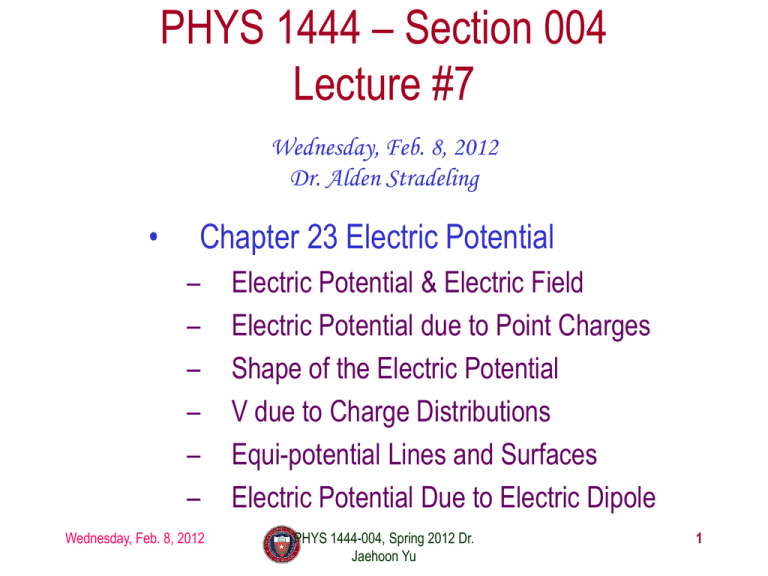
PHYS 1444 – Section 004 Lecture #7 Wednesday, Feb. 8, 2012 Dr. Alden Stradeling • Chapter 23 Electric Potential – – – – – – Wednesday, Feb. 8, 2012 Electric Potential & Electric Field Electric Potential due to Point Charges Shape of the Electric Potential V due to Charge Distributions Equi-potential Lines and Surfaces Electric Potential Due to Electric Dipole PHYS 1444-004, Spring 2012 Dr. Jaehoon Yu 1 Announcements • First term exam – 5:30 – 6:50pm, Wednesday, Feb. 22 – SH103 – CH21.1 through what we learn on Monday, Feb. 20 plus appendices A and B • Reading assignments – CH23.9 Wednesday, Feb. 8, 2012 PHYS 1444-004, Spring 2012 Dr. Jaehoon Yu 2 Reminder: Special Project • Particle Accelerator. A charged particle of mass M with charge -Q is accelerated in the uniform field E between two parallel charged plates whose separation is D as shown in the figure on the right. The charged particle is accelerated from an initial speed v0 near the negative plate and passes through a tiny hole in the positive plate. – Derive the formula for the electric field E to accelerate the charged particle to a fraction f of the speed of light c. Express E in terms of M, Q, D, f, c and v0. – (a) Using the Coulomb force and kinematic equations. (8 points) – (b) Using the work-kinetic energy theorem. ( 8 points) – (c) Using the formula above, evaluate the strength of the electric field E to accelerate an electron from 0.1% of the speed of light to 90% of the speed of light. You need to look up the relevant constants, such as mass of the electron, charge of the electron and the speed of light. (5 points) • Due beginning of the class Monday, Feb. 13 Wednesday, Feb. 8, 2012 PHYS 1444-004, Spring 2012 Dr. Jaehoon Yu 3 Electric Potential and Electric Field • The effect of a charge distribution can be described in terms of electric field or electric potential. – What kind of quantities are the electric field and the electric potential? • Electric Field: Vector • Electric Potential: Scalar – Since electric potential is a scalar quantity, it is often easier to handle. • Well other than the above, what are the connections between these two quantities? Monday, Feb. 6, 2012 PHYS 1444-004, Spring 2012 Dr. Jaehoon Yu 4 Electric Potential and Electric Field • The potential energy is expressed in terms of a conservative force Ub U a b a F dl • For the electrical case, we are more interested in the potential difference: Ub U a Vba Vb Va q b a F dl q b a E dl – This formula can be used to determine Vba when the electric field is given. • When the field is uniform and parallel to the path Vb Va b a E dl E b a dl Ed or Vba Ed Monday, Feb. 6, 2012 field in terms PHYS 1444-004, Spring V/m 2012 Dr. Can you derive this from N/C? 5 Unit of the electric of potential? Jaehoon Yu Example 23 – 3 Uniform electric field obtained from voltage: Two parallel plates are charged to a voltage of 50V. If the separation between the plates is 5.0cm, calculate the magnitude of the electric field between them, ignoring any fringe effect. What is the relationship between electric field and the potential for a uniform field? 5cm 50V V Ed Solving for E Monday, Feb. 6, 2012 50V V 50V 1000V / m E 2 d 5.0cm 5 10 m PHYS 1444-004, Spring 2012 Dr. Jaehoon Yu 6 Electric Potential due to Point Charges • What is the electric field by a single point charge Q at a distance r? Q 1 Q E 4 0 r k 2 r2 • Electric potential due to the field E for moving from point ra to rb in radial direction away from the charge Q is Vb Va rb ra Q 4 0 Wednesday, Feb. 8, 2012 E dl rb ra Q 4 0 rb ra rˆ ˆ rdr 2 r 1 Q 1 1 dr 2 4 0 rb ra r PHYS 1444-004, Spring 2012 Dr. Jaehoon Yu 7 Electric Potential due to Point Charges • Since only the differences in potential have physical meaning, we can choose Vb 0 at rb . • The electrical potential V at a distance r from a single point charge Q is 1 Q V 4 0 r • So the absolute potential by a single point charge can be thought of the potential difference by a single point charge between r and infinity Wednesday, Feb. 8, 2012 PHYS 1444-004, Spring 2012 Dr. Jaehoon Yu 8 Properties of the Electric Potential • What are the differences between the electric potential and the electric field? 1 Q V – Electric potential 4 r 0 • Electric potential energy per unit charge • Inversely proportional to the distance • Simply add the potential by each of the charges to obtain the total potential from multiple charges, since potential is a scalar quantity – Electric field E 1 Q 4 0 r 2 • Electric force per unit charge • Inversely proportional to the square of the distance • Need vector sums to obtain the total field from multiple charges • Potential for the positive charge is larger near the charge and decreases towards 0 at large distance. • Potential for the negative charge is large negative near the charge and increases towards 0 at a large distance. Wednesday, Feb. 8, 2012 PHYS 1444-004, Spring 2012 Dr. Jaehoon Yu 9 Shape of the Electric Potential • So, how does the electric potential look like as a function of distance? – What is the formula for the potential by a single charge? 1 Q V 4 0 r Positive Charge Negative Charge Uniformly charged sphere would have the potential the same as a single point charge. Wednesday, Feb. 8, 2012 What does this mean? PHYS 1444-004, Spring 2012 Dr. 10 Uniformly charged sphere behaves Jaehoon Yulike all the charge is on the single point in the center. Example 23 – 6 Work to bring two positive charges close together: What minimum work is required by an external force to bring a charge q=3.00μC from a great distance away (r=∞) to a point 0.500m from a charge Q=20.0 μC? What is the work done by the electric field in terms of potential energy and potential? q Q Q W qVba 4 0 rb ra Since rb 0.500m, ra we obtain q Q 8.99 109 N m2 C 2 3.00 106 C 20.00 106 C q Q W 1.08 J 0 0.500 m 4 0 rb 4 r 0 b Electric force does negative work. In other words, the external force must work +1.08J to bring the charge 3.00 C from infinity to 0.500m to the charge 20.0 C. Wednesday, Feb. 8, 2012 PHYS 1444-004, Spring 2012 Dr. Jaehoon Yu 11 Electric Potential by Charge Distributions • Let’s consider a case of n individual point charges in a given space and V=0 at r=∞. • Then the potential Via due to the charge Qi at a point a, distance ria from Qi is Qi 1 Via 4 0 ria • Thus the total potential Va by all n point charges is n n Qi 1 Via Va i 1 4 0 ria i 1 • For a continuous charge distribution, we obtain Wednesday, Feb. 8, 2012 V PHYS 1444-004, Spring 2012 Dr. Jaehoon Yu 1 4 0 dq r 12 Example 23 – 8 • Potential due to a ring of charge: A thin circular ring of radius R carries a uniformly distributed charge Q. Determine the electric potential at a point P on the axis of the ring a distance x from its center. • Each point on the ring is at the same distance from the point P. What is the distance? r R2 x2 • So the potential at P is 1 dq 1 What’s this? V dq 4 0 r 4 0 r Q 1 dq 2 2 2 2 4 0 x R 4 0 x R Wednesday, Feb. 8, 2012 PHYS 1444-004, Spring 2012 Dr. Jaehoon Yu 13 Equi-potential Surfaces • Electric potential can be graphically shown using the equipotential lines in 2-D or the equipotential surfaces in 3-D • Any two points on the equipotential surfaces (lines) are on the same potential • What does this mean in terms of the potential difference? – The potential difference between two points on an equipotential surface is 0. • How about the potential energy difference? – Also 0. • What does this mean in terms of the work to move a charge along the surface between these two points? – No work is necessary to move a charge between these two points. Wednesday, Feb. 8, 2012 PHYS 1444-004, Spring 2012 Dr. Jaehoon Yu 14 Equi-potential Surfaces • An equipotential surface (line) must be perpendicular to the electric field. Why? – If there are any parallel components to the electric field, it would require work to move a charge along the surface. • Since the equipotential surface (line) is perpendicular to the electric field, we can draw these surfaces or lines easily. • Since there can be no electric field within a conductor in a static case, the entire volume of a conductor must be at the same potential. • So the electric field must be perpendicular to the conductor surface. Point Parallel Just like a topological map charges Plate Wednesday, Feb. 8, 2012 PHYS 1444-004, Spring 2012 Dr. Jaehoon Yu 15 Electric Potential due to Electric Dipoles • What is an electric dipole? – Two equal point charge Q of opposite signs separated by a distance l and behaves like one entity: P=Ql • For the electric potential due to a dipole at a point p – We take V=0 at r=∞ • The simple sum of the potential at p by the two charges is V Qi 1 1 4 0 ria 4 0 Q Q Q r r r 4 0 Q r 1 1 r r r 4 r r 0 • Since r=lcos and if r>>l, r>>r, thus r~r+r and Q l cos 1 p cos V 4 0 r 4 0 r Wednesday, Feb. 8, 2012 V by a dipole at a distance r from theSpring dipole PHYS 1444-004, 2012 Dr. Jaehoon Yu p cos V 4 0 r16 1
